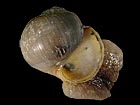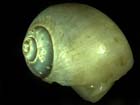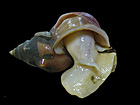Gastropods: snails

Gastropod species diversity in the world oceans seems to peak at mid-continental slope depths and species distribution can be sharply zoned with depth. In the Arctic , ~300 gastropod species are currently known, most of which live at the seafloor. Few specimens have as yet been collected from the Arctic deep-sea.
All mollusks have a muscular foot and some form of hard shell produced by the mantle tissue. In many gastropod species, the shell is spiral and can be closed with a lid-like structure, the operculum, for protection. Unlike their relatives, the bivalves, most snails have a real head with tentacles and eyes at their base.
Most benthic snails feed using a specialized organ called the radula, which is a belt of curved chitinous teeth. Moving across hard surfaces, the radula scrapes off food particles such as algae and encrusting invertebrates. Some snails are predators such as the moon snail Natica (see image), which drills holes into its bivalve prey.
Page Author: Bodil Bluhm
Created: Oct 30, 2008

 Buccinum elatior
Buccinum elatior Cryptonatica affinis
Cryptonatica affinis Littorina saxatilis
Littorina saxatilis Lunatia pallida
Lunatia pallida Margarites helicinus
Margarites helicinus Margarites sp.
Margarites sp. Natica clausa
Natica clausa Neptunea ventricosa
Neptunea ventricosa Tachyrhynchus erosus
Tachyrhynchus erosus